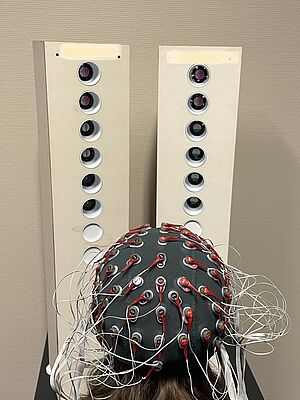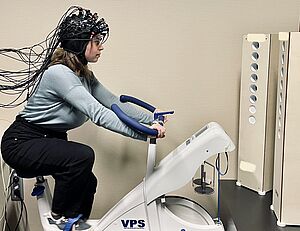
Marine Coeugnet
Research topics
Axis 1: Influence of the characteristics of olfactory stimuli

The first axis of my research focuses on studying the characteristics of olfactory stimuli and their impact on cognitive and emotional engagement. This approach encompasses the entire process, from the odorant molecule to its perception and integration within a specific context, considering the sensory, affective, and cognitive dimensions it engages.
The primary objective of this axis is to better understand how different parameters of olfactory stimuli (particularly their mode of diffusion (direct or ambient olfaction) and their hedonic valence (pleasant, neutral, unpleasant)) influence perception and task engagement. By exploring these variables, this research aims to identify the optimal conditions under which odors can enhance or hinder concentration and motivation.
To ensure an ecologically valid approach, we use realistic diffusion devices, such as olfactory speakers, to recreate olfactory environments similar to those encountered in everyday life: the scent of a bakery on a street corner, the diffusion of an ambient fragrance in a workspace, or interaction with a perfumed individual.
The assessment of these effects relies on a combined approach integrating questionnaires (evaluating odor perception and affect) or the recording of cerebral (EEG and fNIRS) and physiological responses (heart rate and respiration). This methodology allows for the real-time examination of how different characteristics of olfactory stimuli influence cognition and affective states.
Axis 2: Modulation of cognitive effort by odors across a continuum of engagement

The second axis of my research focuses on the influence of odors on cognitive engagement across a continuum of effort, ranging from relaxation to tasks requiring intense cognitive effort. The objective is to examine how the presence of odors, depending on their nature and context of exposure, modulates the perception of effort and individual performance in different activities.
First, we explore the role of odors in relaxation contexts, assessing their ability to promote a state of relaxation and modulate neurophysiological activity associated with cognitive recovery. Next, we examine the influence of odors in tasks involving low cognitive effort, such as active listening, to determine whether they can enhance engagement or, conversely, induce distraction. Finally, we investigate their impact in high cognitive effort contexts, such as creativity and concentration tasks, where attentional demands and mental load are increased.
By integrating these different conditions, this research aims to provide a better understanding of the underlying mechanisms linking olfaction and cognitive effort, identifying the optimal conditions in which odors can be beneficial or, conversely, pose a constraint.
Axis 3: Exploration of Neurophysiological Mechanisms through the Combination of EEG and fNIRS

The third axis of my research focuses on the combination of EEG and fNIRS as a measurement of the impact of odors on cognitive engagement. While the subjective effects of odors on attention and effort have been widely explored, the underlying brain mechanisms and the resources mobilized remain poorly understood. This neurophysiological approach allows us to examine how odors influence brain activation in real-time, taking into account the cognitive and emotional dynamics they evoke.
A major challenge in studying the influence of odors on cognitive effort is the need for a reliable and non-intrusive measurement that is compatible with tasks involving different forms of mental engagement. EEG, providing high temporal resolution, captures the brain's electrical dynamics, while fNIRS, by measuring changes in brain oxygenation, offers complementary information about hemodynamic activity. The combination of these two techniques thus provides a more comprehensive view of the neural processes involved in the modulation of effort by olfactory stimuli.
Through this multimodal approach, our research aims to objectify the effect of odors on cognitive engagement by exploring the links between olfactory perception, brain activation, and behavioral performance.



